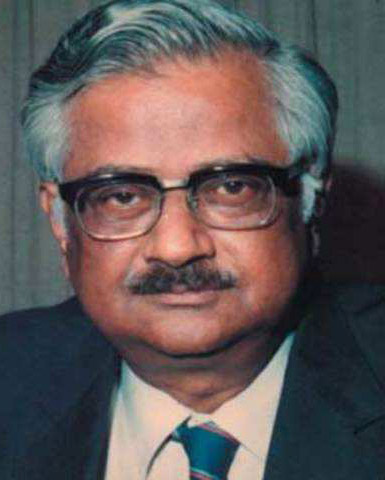Born On: January 28, 1925
Born In: Tumkur, Karnataka
Died On: September 24, 2004
Career: Nuclear Scientist, Nuclear Physicist
Nationality: Indian
Handpicked by the founder of India's nuclear program, Dr. Homi Bhabha, Dr. Raja Ramanna was a celebrated physicist and nuclear scientist that India had ever produced. A multifaceted personality, Dr. Raja Ramanna played the roles of a technologist, nuclear physicist, administrator, leader, musician, Sanskrit literature scholar, and philosophy researcher. To complete the endless list of honors that this nobleman was gifted with, he was a complete human being. Following the steps of his ideals Dr. Homi Bhabha and Vikram Sarabhai, Ramanna managed to grab a major position in shaping India's energy and security programs. He is regarded as one of the most successful creators of science and technology in India with the tremendous success of India's peaceful explosion experiment.
Early Life
Raja Ramanna was born to B. Ramanna and Rukminiamma in the busy industrial town of Tumkur in Karnataka. His father was highly reputed and served as a judge in the judicial service of Mysore state. His mother was highly intelligent and loved to read. She often read Shakespeare and Charles Dickens, though her favorite was Sir Walter Scot. Apart from gaining immense influence and inspiration from his parents, Ramanna was greatly touched by his mother's sister Rajamma, who was widowed at an early age but with his grandfather's support, she managed to move ahead and became the headmistress of a Government Middle School earning fifty rupees a month. Ramanna had his early education in Mysore, but when the family shifted to Bangalore, he was admitted to Bishop Cotton Boys' School. On completion of matriculation, he went to St. Joseph's School for his intermediate studies. He joined the Madras Christian College in Tambaram for B. Sc (Hons) degree in physics and graduated in 1945. He later traveled to England to attain his doctoral degree in nuclear physics from King's College, London. In 1948, Ramanna successfully obtained his PhD degree.
TIFR Career
Ramanna was extremely fond and highly influenced by Homi Jehangir Bhabha and was fortunate to meet him in 1944. He was introduced by an examiner at Trinity College of Music, Dr. Alfred Mistowski, who stayed back in India at the outbreak of World War II. Though Ramanna was still a science student, he was sure that this was not his first and only meeting with Homi Bhabha. On his tour to London, Homi Bhabha offered Ramanna a job at Tata Institute of Fundamental Research (TIFR), the cradle of India's atomic energy program. Thus, on his completion of his PhD degree, Ramanna joined TIFR on December 1, 1949. Due to the relocation and renovation of the institute from Cumbala Hills in Mumbai to Yacht Club, Ramanna was offered two adjacent rooms on the fourth floor in Yacht Club by Homi Bhabha, seeing his interest in music. While the first room was for Ramanna, the second one was for his piano. Further, the ground floor became the nuclear laboratory of physics from where he started his project on nuclear fission and scattering. Here, he made several contributions in different areas of neutron, nuclear, and reactor physics.
BARC Career
Ramanna organized physics and rector physics programs at Bhabha Atomic Research Center (BARC), Trombay. In 1956, when India's first nuclear reactor, Apsara, was commissioned by Homi Bhabha, Ramanna was one of the youngest reactor physicists in the team. However, the major advancement came when BARC Training School was established in 1957 to develop the skilled manpower required for facing the challenging problems in nuclear science and technology under the leadership of Ramanna. It was under his directorship that India carried out the first nuclear test in Pokhran in 1974, nicknamed as Operation Smiling Buddha. He held the position of the Director of BARC from 1972-78 and 1981-83.
Later Life
Raja Ramanna was associated with a number of science academies and learning bodies across India. He helped in setting up the Centre for Advanced Technology at Indore in the early 1980s, which was dedicated towards the development of advanced accelerators, lasers, and other related technologies. Further, he even lent his support in the establishment of Variable Energy Cyclotron Centre (VEC) in Kolkata. He later ended up becoming the founder-Director of National Institute of Advanced Studies (NIAS), an institution set up by JRD Tata in Bangalore. Ramanna served his later years in supporting science institutions throughout the nation as President of Indian National Science Academy, Scientific Advisor Committee to Director General of International Atomic Energy Agency, President of 30th General Conference of the International Atomic Energy Agency, Vice President of Indian Academy of Sciences, President of Indian National Science Academy, and President of General Conference of Atomic Energy Agency at Vienna. He was honored with numerous accolades during his entire career tenure.
Death
Raja Ramanna passed away on September 24, 2004 in Mumbai after a cardiac arrest. Till date, he is highly honored and respected in India and Pakistan, and often known as the "Father of the Indian Nuclear Program".
Honors
Shanti Swarup Bhatnagar Award, 1963
Padma Shri Award, 1968
Padma Bhushan Award, 1973
Padma Vibhushan Award, 1975
Meghnad Saha Medal of the Indian National Science Academy, 1984
Om Prakash Bhasin Award, 1985
R.D. Birla Memorial Award, 1986
Asutosh Mookerji Gold Medal, 1996
D.Sc. (Honoris Causa) by several universities
Posts Held
Chairman, Governing Council, Indian Institute of Science, Bangalore
Council of Management, Jawaharlal Nehru Centre for Advanced Scientific Research, Bangalore
Chairman, Board of Governors, Indian Institute of Technology, Bombay, 1972-78
President, Indian National Science Academy, 1977-78
Vice-President, Indian Academy of Sciences, 1977-79
Scientific Adviser to the Minister of Defence, 1978-81
Director-General of Defence Research and Development Organization (DRDO) , 1978-81
Secretary for Defence Research, Government of India
Chairman, Atomic Energy Commission, 1983-87
President, General Conference of Atomic Energy Agency, Vienna, 1986
Secretary, Department of Atomic Energy
Director, Bhabha Atomic Research Centre, 1972-78 and 1981-83
Director, National Institute of Advanced Studies, IISC campus, Bangalore, 1987-89 and 1990-97



